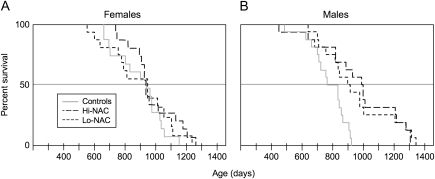Figure 3.
Kaplan–Meier plots of survival curves comparing a control group with N-acetyl-L-cysteine (NAC)–treated groups. Each group consisted of 32 UM-HET3 (HET3) mice, 16 mice of each sex. We treated mice with either 10 g (hi-NAC) or 5 g (lo-NAC) NAC per liter of drinking water starting at 7 months of age. Treatment was continued until mice died or became moribund. The control group was a separate group of HET3 mice from the control group in the diet restriction study. The effect of NAC treatment on life span differed by sex (interaction of sex and treatment in the proportional hazards model, p = .02, likelihood ratio chi-square test); therefore, we analyzed females separately from males. (A) NAC treatment did not affect life span in females. (B) NAC treatment increased life span in males (p = .004, likelihood ratio chi-square test). Each NAC dose had a similar effect (low dose p = .008; high dose p = .0007, likelihood ratio chi-square tests in separate proportional hazards models for each dose). Data were censored for missing mice at the following ages (days): female control, 629 days; female low dose, 791 and 868 days; and female high dose, 292 days. No data were censored for male mice.

